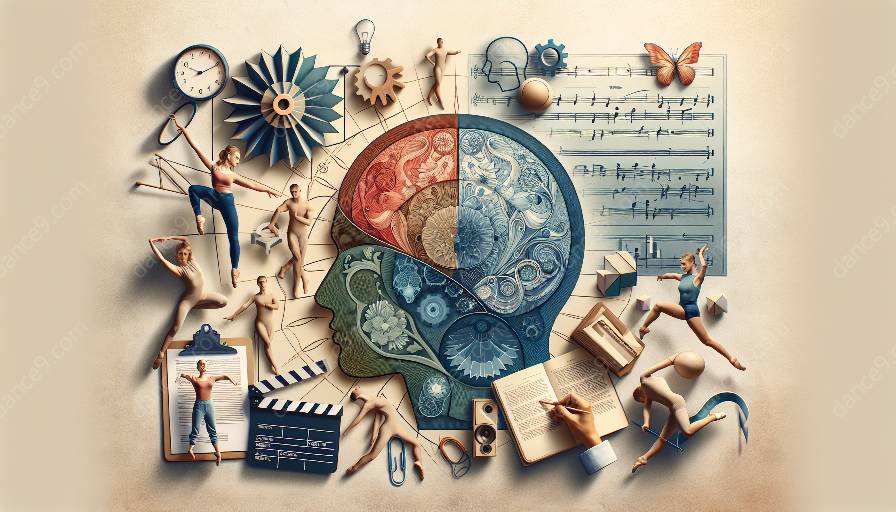Dance is not merely a physical activity; it also encompasses a myriad of psychological challenges that impact the mental and physical well-being of dancers. These challenges are integral to the performing arts, and understanding and addressing them is essential for fostering a healthy and sustainable dance environment.
Understanding Psychological Challenges in Dance
The Mental and Emotional Demands
Dance requires not only physical prowess but also significant mental and emotional resilience. Dancers often face immense pressure to perform flawlessly, meet strict aesthetic standards, and navigate competitive environments. These demands can lead to stress, anxiety, and even performance-related psychological issues.
Body Image and Self-Esteem
The aesthetic nature of dance can contribute to body image issues and low self-esteem among dancers. The pursuit of an ideal body shape and size, as well as the constant scrutiny of one's physical appearance, can lead to negative psychological impacts.
Impact on Physical and Mental Health
Emotional Well-Being
The psychological challenges in dance can have profound effects on emotional well-being. Dancers may experience heightened levels of stress, performance anxiety, and even depression, all of which can affect their overall mental health and quality of life.
Physical Health
The psychological challenges in dance are closely intertwined with physical health. Stress and anxiety can manifest as muscle tension, fatigue, and increased risk of injury. Additionally, the pressure to achieve a certain body image can lead to disordered eating habits and other physical health concerns.
Strategies for Managing Psychological Challenges
Supportive Environment
Creating a supportive and understanding dance environment is crucial for addressing psychological challenges. Open communication, empathy, and a culture of inclusivity can help alleviate the stress and pressure experienced by dancers.
Mental Health Resources
Access to mental health resources is vital for dancers. Providing education about mental health, offering counseling services, and promoting self-care practices can empower dancers to prioritize their mental well-being.
Body Positivity and Self-Compassion
Promoting body positivity and fostering self-compassion can contribute to a healthier dance community. Emphasizing the value of diverse body types and encouraging positive self-talk can help combat negative body image issues.
Intersecting Psychology and Dance
Therapeutic Benefits of Dance
Despite the psychological challenges, dance also offers therapeutic benefits. Movement, expression, and artistic creativity in dance can serve as outlets for emotional release, stress reduction, and self-expression.
Mind-Body Connection
Exploring the mind-body connection is essential for understanding the psychological aspects of dance. Practices such as mindfulness, meditation, and cognitive behavioral techniques can aid dancers in managing stress and enhancing their mental resilience.
Conclusion
Psychological challenges in dance are multifaceted and pervasive, impacting not only the mental well-being of dancers but also their physical health and overall performance. By acknowledging and addressing these challenges, the dance community can cultivate an environment that promotes holistic well-being and empowers dancers to thrive both psychologically and physically.
Topic
Understanding Psychological Challenges in Dance
View details
Strategies for Balancing Mental and Physical Health in Dance
View details
Educational Resources for Addressing Psychological Challenges
View details
Impact of Psychological Challenges on Physical Health in Dance
View details
University Support Systems for Dancers' Mental Health
View details
Integrating Mental Health Education into Dance Programs
View details
Interpersonal Relationships and Psychological Challenges in Dance
View details
Managing Performance Anxiety and Psychological Stress
View details
Long-Term Effects of Psychological Challenges on Dancers' Careers
View details
Identifying and Addressing Psychological Challenges in Dance Education
View details
Stress Management and its Impact on Physical Health in Dance
View details
Holistic Approach to Mental and Physical Health for Dancers
View details
Impact of Psychological Challenges on Artistic Expression in Dance
View details
Maintaining Positive Mental Well-Being in Intense Dance Environments
View details
The Role of Self-Awareness in Addressing Psychological Challenges
View details
Overcoming Self-Doubt and Insecurity in Competitive Dance
View details
Combatting Stigma and Misconceptions about Psychological Challenges in Dance
View details
Fostering a Culture of Openness and Support in Universities
View details
Questions
What are common psychological challenges faced by dancers?
View details
How can dancers maintain their mental health while pursuing a career in dance?
View details
What educational resources are available for addressing psychological challenges in dance?
View details
How can dancers develop resilience in the face of psychological challenges?
View details
What impact do psychological challenges have on a dancer's physical health?
View details
How can universities support dancers in managing psychological challenges?
View details
What are effective coping strategies for psychological challenges in the context of dance?
View details
What role does self-care play in addressing psychological challenges in dance?
View details
How can dancers build a support system to navigate psychological challenges?
View details
What are the benefits of integrating mental health education into dance programs?
View details
How do psychological challenges influence a dancer's performance?
View details
In what ways can psychological challenges affect a dancer's relationships with peers and instructors?
View details
What techniques can dancers use to manage performance anxiety and psychological stress?
View details
What are the long-term effects of psychological challenges on a dancer's career?
View details
How can educators and instructors identify and address psychological challenges in their dance students?
View details
What are the effects of stress on a dancer's physical health and well-being?
View details
How can universities promote a holistic approach to mental and physical health for dancers?
View details
What psychological support systems are available for university dancers?
View details
How can dancers develop a healthy work-life balance while pursuing a career in dance?
View details
How do psychological challenges impact a dancer's creativity and artistic expression?
View details
What strategies can dancers use to maintain positive mental well-being during periods of intense training and performance?
View details
What role does self-awareness play in addressing psychological challenges in dance?
View details
How can dancers overcome feelings of self-doubt and insecurity in the competitive dance environment?
View details
What are the stigmatization and misconceptions surrounding psychological challenges in dance and how can we combat them?
View details
How can universities foster a culture of openness and support regarding psychological challenges in dance?
View details


































